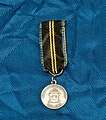Southern Army Division
The Southern Army Division (Swedish: Södra arméfördelningen, 13. förd), was a division of the Swedish Army that operated in various forms from 1941 until 2000. Its staff was located in Kristianstad Garrison in Kristianstad.[2] The unit was disbanded as a result of the disarmament policies set forward in the Defence Act of 2000.
| Southern Army Division | |
|---|---|
| Södra arméfördelningen | |
 | |
| Active | 1941–2000 |
| Country | Sweden |
| Allegiance | Swedish Armed Forces |
| Branch | Swedish Army |
| Type | Infantry |
| Size | Army Division |
| Part of | Skaraborg Regiment (1946–1984) North Scanian Regiment (1984–1994) Southern Military Area (1994–2000) |
| Garrison/HQ | Kristianstad |
| March | "Kavalleri V" (Lidner)[note 1] |
Heraldry and traditions
Coat of arms
The coat of arms of the Eastern Army Division used from 1994 to 2000. Blazon: "Sable, the front of a tank with three bolts coming from each side of the turret, or. The shield surmounted two batons or, charged with open crowns azure, in saltire or."[3]
Medals
In 2000, the Södra arméfördelningens (13.förd) minnesmedalj ("Southern Army Division (13.förd) Commemorative Merit") in silver (SFördSMM) of the 8th size was established. The medal ribbon is of black moiré with blue lines at the edges and two yellow lines on the middle.[4]
 Southern Army Division Commemorative Merit.
Southern Army Division Commemorative Merit. Southern Army Division Commemorative Merit (miniature model).
Southern Army Division Commemorative Merit (miniature model). Ribbon.
Ribbon.
Commanding officers
- 1994–1995: Colonel 1st Class Håkan Waernulf
- 1995–1998: Colonel 1st Class Björn Ivar Hedskog
- 1998–2000: Colonel 1st Class Mats Welff
Names, designations and locations
| Name | Translation | From | To | |
|---|---|---|---|---|
| XIII. arméfördelningen | XIII Army Division | 1941-08-01 | – | 1966-09-30 |
| 13. arméfördelningen | 13th Army Division | 1966-10-01 | – | 1994-06-30 |
| Södra arméfördelningen | Southern Army Division | 1994-07-01 | – | 1997-12-31 |
| Designation | From | To | ||
| XIII. förd | 1941-08-01 | – | 1966-09-30 | |
| 13. förd | 1966-10-01 | – | 1997-12-31 | |
| Location | From | To | ||
| Skövde Garrison | 1941-08-01 | – | 1984-06-30 | |
| Kristianstad Garrison | 1984-07-01 | – | 2000-06-30 |
See also
Footnotes
- The march was established on 13 June 1996 by TFG 960005.[1]
References
Notes
- Sandberg 2007, p. 48
- Braunstein 2003, pp. 311–312
- Braunstein 2006, p. 18
- Braunstein 2007, p. 107
Print
| Wikimedia Commons has media related to Southern Army Division. |
- Braunstein, Christian (2003). Sveriges arméförband under 1900-talet. Skrift / Statens försvarshistoriska museer, 1101-7023 ; 5 (in Swedish). Stockholm: Statens försvarshistoriska museer. ISBN 91-971584-4-5. SELIBR 8902928.CS1 maint: ref=harv (link)
- Braunstein, Christian (2006). Heraldiska vapen inom det svenska försvaret [Heraldry of the Swedish Armed Forces] (PDF). Skrift / Statens försvarshistoriska museer, 1101-7023 ; 9 (in Swedish). Stockholm: Statens försvarshistoriska museer. ISBN 91-971584-9-6. SELIBR 10099224.CS1 maint: ref=harv (link)
- Braunstein, Christian (2007). Utmärkelsetecken på militära uniformer [Decorations on Swedish military uniforms] (PDF). Skrift / Statens försvarshistoriska museer, 1101-7023 ; 12 (in Swedish). Stockholm: Statens försvarshistoriska museer. ISBN 978-91-976220-2-8. SELIBR 10423295.CS1 maint: ref=harv (link)
- Sandberg, Bo (2007). Försvarets marscher och signaler förr och nu: marscher antagna av svenska militära förband, skolor och staber samt igenkännings-, tjänstgörings- och exercissignaler (in Swedish) (New ed.). Stockholm: Militärmusiksamfundet med Svenskt marscharkiv. ISBN 978-91-631-8699-8. SELIBR 10413065.CS1 maint: ref=harv (link)